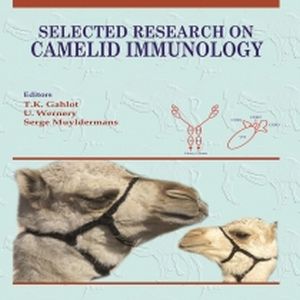
From the preface: The camelid functional immunoglobulin devoid of light chains is among the important discoveries made in the late 1980s by scientists at the ‘Vrije Universiteit Brussel’ (Free University of Brussels). Accordingly, during a practical course, biology students were to extract antibodies from human blood serum but the students thought that the samples might be contaminated with HIV, and moreover, it was well documented in their textbooks. Eventually a few litres of frozen dromedary serum were discovered in the lab freezer - this exotic example inspired the students sufficiently to start working on the antibody separation. In addition to the usual distribution of immunoglobins, they also discovered a group of smaller antibodies that did not correspond to anything known to science. This might have ended in obscurity, had not two supervisors, Professor Raymond Hamers and Dr Cecile Casterman, investigated the matter more deeply. They did not accept that these antibody species were just degraded variants of the ‘real’ antibodies, but started to characterise them in more detail. Eventually, it became clear that they had discovered a new class of antibodies that were devoid of light chains and had a single antigen recognising domain. These unique antibodies were later found in all camelid species, including llamas and alpacas (Source: Michael Gross’s book ‘The birds, the Bees and the Platypuses’).
In 1989 a group of biologists led by Raymond Hamers at the Free University Brussels investigated the immune system of dromedaries. In addition to the expected four-chain antibodies, they identified simpler antibodies consisting only of two heavy chains. This discovery was published in Nature in 1993. Based on their structure, these peculiar camelid antibodies have been named Heavy Chain Antibodies (HCAb), as they are composed of heavy chains only and are devoid of light chains. HCAbs are not found in other mammals except in pathological cases. Sera of camelids contain both conventional heterotetrameric antibodies and unique functional heavy (H)-chain antibodies (HCAbs). The genetic elements composing HCAbs have been identified, but the in vivo generation of these antibodies from their dedicated genes into antigen-specific and affinity-matured bona fide antibodies remains largely under investigated. However, the facile identification of antigen-specific VHHs and their beneficial biochemical and economic properties (size, affinity, specificity, stability, production cost) supported by multiple crystal structures have encouraged antibody engineering of these single-domain antibodies for use as a research tool and in biotechnology and medicine.
The smaller size and monomeric single domain nature make these antibodies easier to transform into bacterial cells for bulk production, making them ideal for research purposes. Single-domain antibodies are being researched for multiple pharmaceutical applications and have potential for use in the treatment of acute coronary syndrome, cancer and myeloid (e.g. Alzheimer's) disease. Camelid scientists world over were greatly fascinated by a new field of research called ‘Camelid Immunology’. Camel has low susceptibility to pathogens has led to a belief that camel's immune system is either more potent in combating the infections or is unique and different from other mammalian species. Significant research has been done on camelid immunology in recent decade. The term ‘nanoantibody’ or ‘nanobody’ was given to the recombinant single-domain antigen-binding variable fragments of special type of antibodies (i.e. HCAbs) that naturally exist (in addition to classical types of antibodies) in blood of Camelidae family animals. These nanobodies have a big potential for employment in immune biotechnology and medicine. In order to benefit future camelid immunology researchers, this book was planned in the series of ‘Selected Topics’.
This book is a unique compilation of research papers based on ‘Camelid Immunology’and published in Journal of Camel Practice and Research between 1994-2015. Research on this subject was done in 30 countries involving about 248 scientists. In terms of number of published papers in JCPR on the immunology the following countries remain in order of merit (in parenthesis), i.e. Iran (1), India and UAE (2), China and Saudi Arabia (3), Sudan (4), Kenya and Belgium (5), USA (6), Germany (7) and so on. The book contains 11 sections and is spread in 384 pages. The diverse sections are named as overview of camel immune system; determinates of innate immunity, cells, organs and tissues of immune system; antibodies; immunomodulation; histocompatibility; seroprevalence, diagnosis and immunity against bacteria, viruses, parasites and combination of other infections; application of camel immunoglobulins and applications of immune mechanisms in physiological processes.
This reference book may prove quite useful for those interested in this subject.